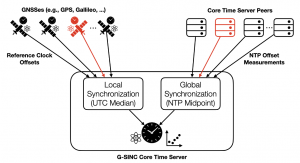G-SINC: Global Synchronization Infrastructure for Network Clocks

Status
This project started in October 2022 and is ongoing.
Researchers
Marc Frei (ETH)
Dr. Jonghoon Kwon (ETH)
Seyedali Tabaeiaghdaei (ETH)
Marc Wyss (ETH)
Prof. Dr. Adrian Perrig (ETH)
Dr. Christoph Lenzen (CISPA)
Description
Secure and dependable time synchronization is an essential prerequisite for many industries with applications in finance, telecommunication, electric power production and distribution, or environmental monitoring.
Current best practice to achieve large-scale time synchronization relies on global navigation satellite systems (GNSSes) at the considerable risk of being exposed to outages, malfunction, or attacks against availability and accuracy. Natural disasters like solar superstorms also have the potential to hit and severely impact GNSSes.
It is therefore all too apparent that time synchronization solely based on GNSSes as global reference clocks does not fulfill fundamental dependability requirements for systems that serve indispensable functionalities in our society. Facing these concerns, governments have issued mandates to protect critical infrastructure services from disruption to GNSS services, including a 2020 US Executive Order. Operators and equipment manufacturers are encouraged to intensify research and development of alternative technologies in this space.
Aiming to join these efforts, we are developing G-SINC: a novel global, Byzantine fault-tolerant clock synchronization approach that does not place trust in any single entity and is able to tolerate a fraction of faulty entities while still maintaining accurate synchronization on a global scale among otherwise sovereign network topologies. G-SINC can be implemented as a fully backward compatible active standby solution for existing time synchronization deployments.
This is achieved by building on the solid body of fault-tolerant clock synchronization research dating all the way back to the 1980s and the SCION Internet architecture providing required resilience and security properties at the network level as an intrinsic consequence of its underlying design principles. Besides the possibility to use multiple distinct network paths in parallel for significantly improved fault-tolerance, we highlight the fact that SCION paths are reversible and therefore symmetric. Hence, they help to increase time synchronization precision compared to clock offset measurements over the often asymmetric paths in today’s Internet.
Publications
In Proceedings of the Symposium on Reliable Distributed Systems (SRDS) 2022.
[PDF] [arXiv]
